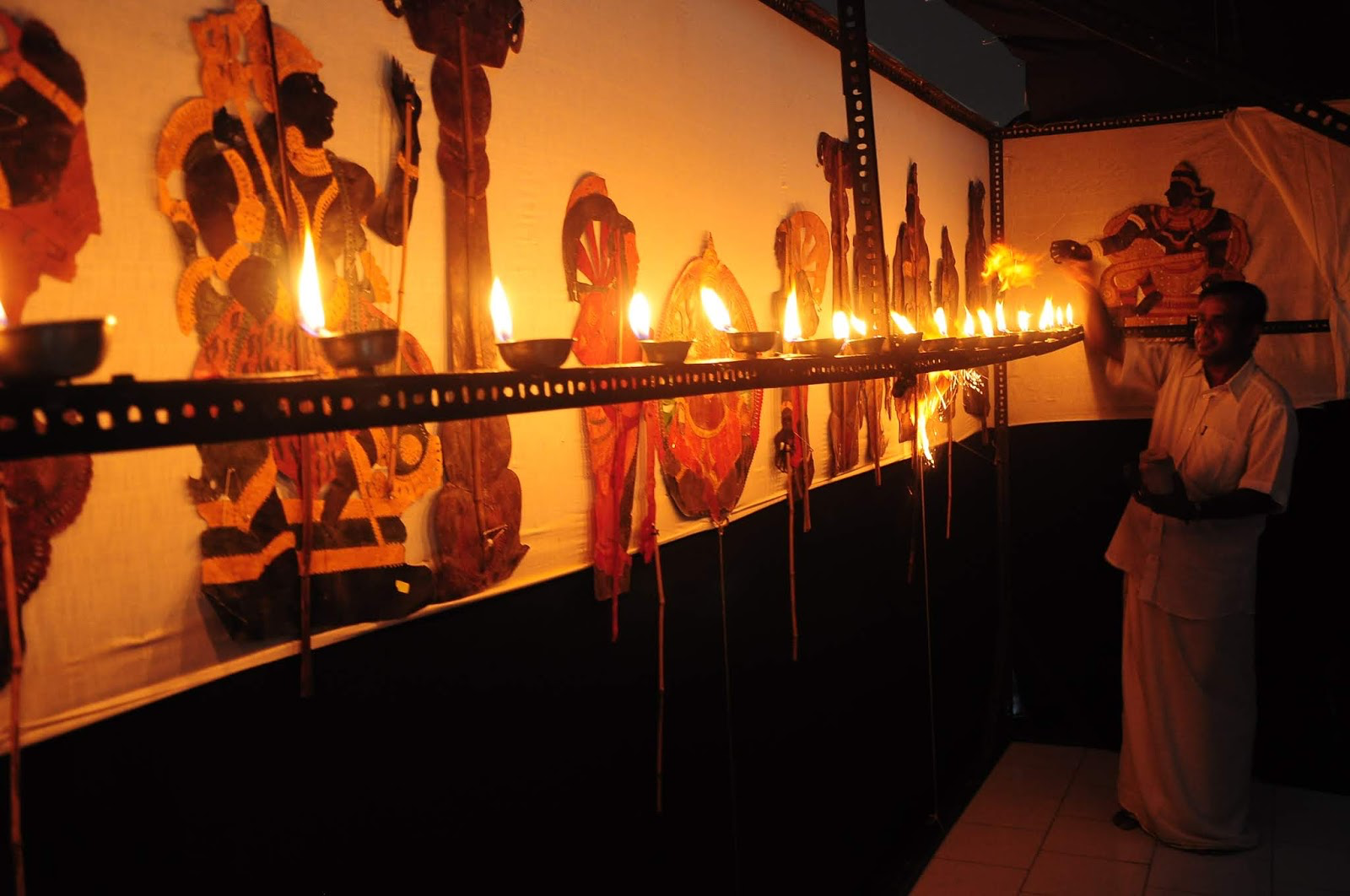
When dusk settles across the red earth of rural Kerala and temple lamps begin to glow, an extraordinary kind of theatre begins. Behind a long white cloth screen, shadows of gods and demons rise in flickering movement. You hear the pulse of chenda drums, the hum of chants passed down generations, and then through oil-lit silhouettes epic stories unfold. This is Tholpavakoothu, Kerala's age-old shadow puppet theatre, where leather puppets dance between light and soul, echoing centuries of devotion, storytelling, and artistic inheritance.
Where Art is a Living Ritual, Not Just a Performance
Unlike stage-bound theatre, Tholpavakoothu is not merely seen it is felt. Performed predominantly in Bhagavathi temples in the districts of Palakkad, Thrissur, and Malappuram, this art form is woven into ritual, offered as a devotional tribute to the goddess Bhadrakali**. It is believed that the goddess, who missed witnessing Rama's battle with Ravana while slaying the demon Darika, now watches it retold each year through this sacred shadow play.
Each performance unfolds not in hours but in nights. Traditional Tholpavakoothu can last 7 to 41 consecutive nights, starting after dusk and ending before dawn. The narrative, drawn from the Tamil Ramayana (Kamba Ramayanam), is told through thousands of memorized verses, chant-like narration, and rhythmic percussion.
The Stage, the Light, the Magic of Shadows
The theatre itself is humble yet hypnotic- a raised wooden stage called the Koothumadam, with a white cloth screen at the front. Behind it, 21 oil lamps flicker, casting a golden glow on leather puppets held by the puppeteers. These puppets, once made from deer hide and now from goat skin, are intricately etched and colored with natural dyes. Each puppet some nearly four feet tall?represents gods, demons, animals, or celestial beings. Manipulated using bamboo rods, the puppets move with startling realism, their gestures magnified by shadow.
As the story unfolds, you don't just watch you become part of it. The sound of the maddalam and chenda, the chants in Sanskrit, Malayalam, and Tamil, and the smell of oil lamps and incense make the performance a sensory pilgrimage. The language may be ancient, but the emotion is immediate.
The Families Who Hold the Light
What makes Tholpavakoothu deeply moving is not just its art, but its people. This tradition is not run by institutions it is preserved within families, passed down like sacred fire. Master puppeteers, known as Pulavars, are custodians of not just performance, but of knowledge, language, mythology, and memory.
To become a Pulavar is no casual feat. It requires years of trainin in classical music, percussion, puppetry, Sanskrit texts, and spiritual discipline. Most begin as children, assisting elders during the performances. By the time they command the screen, they have already absorbed a world of meaning.
These artist families live humbly, often farming or working small jobs, yet they dedicate months each year to preparing and performing the Koothu. Their hands shape the puppets, their voices carry the verses, and their devotion keeps alive a tradition that predates modern entertainment by centuries.
A Cultural Treasure at Risk and in Revival
Like many traditional art forms, Tholpavakoothu has seen dwindling patronage. Fewer temples commission long-form performances, and audiences have been drawn away by modern media. Yet, a quiet revival is taking place thanks to dedicated artists like K. K. Ramachandra Pulavar, who received national honors for his efforts to bring Tholpavakoothu to schools, cultural festivals, international stages, and even films.
These artists are adapting creating performances based on the lives of Mahatma Gandhi, social themes, and health awareness campaigns. But the heart of the tradition remains: storytelling through shadow and spirit, connection through ritual and rhythm.
When You Travel to See It, You Don't Just Watch You Belong
To witness Tholpavakoothu is not to attend a show, but to **step into a living tradition**. You sit among local families under the night sky, feel the ground cool beneath your feet, and lose track of time as myth and music take over. You may even be invited backstage to feel the etched puppets, to meet the artists, to hear their stories, and perhaps hold a shadow between your fingers.
It is perfect for travelers who seek depth over distraction, those curious about Kerala's soul beyond its landscapes. Tholpavakoothu reveals the part of India that still believes storytelling is sacred.
Where and How to Experience It
Tholpavakoothu is performed in around 80 temples in Kerala during annual festivals between January and May, particularly in villages around Palakkad, Thrissur, Shoranur, and Ottapalam. For a complete experience, plan your trip around the temple festivals of Bhadrakali shrines, or attend curated performances by artist families.
If you?d prefer an arranged visit, City Heritage helps you access these rare experiences without disrupting their authenticity.
City Heritage Helps You Witness Living Art
At City Heritage, we don't believe in sightseeing -we believe in soul-seeing. Our curated experiences in Kerala introduce you to families who have kept Tholpavakoothu alive for generations. We take you behind the screen, into the artist's home, the workshop, the prayer room where puppets are blessed, and finally to the glowing stage where shadows dance and divinity whispers.
With us, you don't just travel - you touch living culture, you feel the warmth of tradition, and you return home with more than memories.
Visit us and contact:
For heritage tours, cultural experiences, and meaningful collaborations
Get in Touch:
Visit: www.cityheritage.in
Email: mail@cityheritage.in
Instagram: cityheritage.in
Phone: +91 7356569573, +91 8377024979
© Copyright 2026 City Heritage. All rights reserved.
Website designed by TNM Online Solutions.
If you have any enquiry, feel free to ask, and we'll provide you with a prompt and concise response.